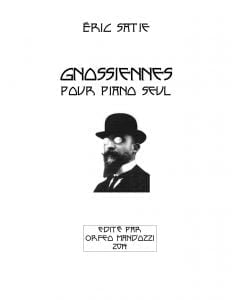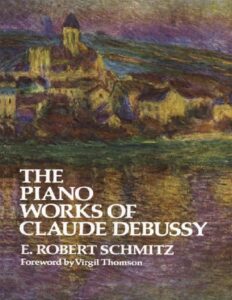Come join us now, and enjoy playing your beloved music and browse through great scores of every level and styles!
Can’t find the songbook you’re looking for? Please, email us at: sheetmusiclibrarypdf@gmail.com We’d like to help you!
Erik Satie – Gnossienne 1 – Otto Tolonen, guitar (with sheet music)

Erik Satie
Éric Alfred Leslie Satie was a French pianist and avant-garde composer. He was also famous for being an author, some of his most famous works were published in “Vanity Fair” and “Dadaist
Erik Satie was born on May 17, 1866 in Honfleur, Normandy. At the age of six, the young Satie was forced to move to his paternal grandparent’s house upon the news of his mother’s death. There, his grandparents arranged for his first lessons in music. These lessons continued until age twelve, after which the young Satie reunited with his father, who had now married a piano teacher. Satie then continued his music education with his stepmother and at the age of thirteen, he joined the famous Paris Conservatoire.
However, his time at the Conservatoire was not be easy, as his teachers severely disliked his playing style. His teachers often remarked that he was “the laziest student in the Conservatoire”. Satie, dissatisfied with his time at the Conservatoire left it to serve for a year in the army. However, his teachers at the Conservatoire who suggested to him to take up composition.
Satie’s father published three of Satie’s works in 1886. They were titled “Elegie”, “Trois Melodies” and “Chanson”. Satie soon followed up his initial compositions with more eccentric works such as “Gymnopedies”, ”Ogives”, and “Gnossiennes”. In 1887 Satie befriended the famous French Impressionist Composer Claude Debussy, and the two often discussed the latest trends in music.

Satie also found inspiration from the artistic gatherings at the famous “Le Chat Noir Café-Cabaret”. However, this was a difficult time for Satie financially. He survived as a cabaret pianist, adapting popular music for the piano. During this period, Satie wrote the music for a pantomime by Jules Depaquit titled “Jack in the Box”.
In 1905, Satie decided to try his luck at counterpoint. He enrolled in the Schola Cantorum de Paris under Vincent d’Indy. His newfound efforts to better himself served as a precursor to his celebrity status. By 1912, Satie partnered with the Spanish Pianist Robert Vines to release a serious of humorous piano shorts.
These piano shorts showered Satie with praise and attention, and it led people to investigate and rediscover many of Satie’s lost works. This era saw one of his earliest works, Gymnopedies, earn plenty of praise and acclaim. Satie also had the French Composer Maurice Ravel to thank for much of his fame, as he pointed out Satie’s genius to France’s elite.
Post 1912 Satie wrote a number of orchestral and instrumental works. In 1918 he wrote the “Musique d’ameublement”, and in 1914 he wrote the “Autre Choral”. He also wrote ten dramatic pieces after 1912. In 1917, he wrote one of his largest vocal works, the “Socrate: Drame Symphonique”.
Erik Satie died on July 1, 1925 in Paris, France. He developed the cirrhosis of the liver, together with pleurisy, which claimed his life. Satie received the last rites of the Catholic Church in his death bed. In his honor, a tiny stone monument has been erected. Satie received plenty of posthumous attention, his friends and colleagues discovered many of his works that remained unpublished. This included the orchestral score to “Parade”, “Vexations”, and many additions to “The Dreamy Fish” and the Schola Cantorum Exercises.
The Gnossiennes
The Gnossiennes are several piano compositions written by the French composer Erik Satie in the late 19th century. The works are for the most part in free time (lacking time signatures or bar divisions) and highly experimental with form, rhythm and chordal structure. The form as well as the term was invented by Satie.
Etymology
Satie’s coining of the word gnossienne was one of the rare occasions when a composer used a new term to indicate a new “type” of composition. Satie used many novel names for his compositions (vexations, croquis et agaceries and so on). Ogive, for example, is the name of an architectural element which was used by Satie as the name for a composition, the Ogives. Gnossienne, however, was a word that did not exist before Satie used it as a title for a composition.
The word appears to derive from gnosis. Satie was involved in gnostic sects and movements at the time that he began to compose the Gnossiennes. However, some published versions claim that the word derives from Cretan “knossos” or “gnossus”; this interpretation supports the theory linking the Gnossiennes to the myth of Theseus, Ariadne and the Minotaur. Several archeological sites relating to that theme were famously excavated around the time that Satie composed the Gnossiennes.
It is possible that Satie may have drawn inspiration for the title of these compositions from a passage in John Dryden‘s 1697 translation of the Aeneid, in which it is thought the word first appeared:
Let us the land which Heav’n appoints, explore;
Appease the winds, and seek the Gnossian shore.
Characteristics
The Gnossiennes were composed by Satie in the decade following the composition of the Sarabandes (1887) and the Trois Gymnopédies (1888). Like these Sarabandes and Gymnopédies, the Gnossiennes are often considered dances. It is not certain that this qualification comes from Satie himself – the sarabande and the gymnopaedia were at least historically known as dances.
The musical vocabulary of the Gnossiennes is a continuation of that of the Gymnopédies (a development that had started with the 1886 Ogives and the Sarabandes) later leading to more harmonic experimentation in compositions like the Danses gothiques (1893). These series of compositions are all at the core of Satie’s characteristic late 19th century style, and in this sense differ from his early salon compositions (like the 1885 “Waltz” compositions published in 1887), his turn-of-the-century cabaret songs (Je te veux), and his post-Schola Cantorum piano solo compositions, starting with the Préludes flasques in 1912.
Trois Gnossiennes
These Three Gnossiennes were composed around 1890 and first published in 1893. A revision prior to publication in 1893 is not unlikely; the 2nd Gnossienne may even have been composed in that year (it has “April 1893” as date on the manuscript). The piano solo versions of the first three Gnossiennes are without time signatures or bar lines, which is known as free time.
These Gnossiennes were first published in Le Figaro musical No. 24 of September 1893 (Gnossiennes Nos. 1 and 3, the last one of these then still “No. 2”) and in Le Cœur No. 6–7 of September–October 1893 (Gnossienne No. 2 printed as facsimile, then numbered “No. 6”).
The first grouped publication, numbered as known henceforth, followed in 1913. By this time Satie had indicated 1890 as composition date for all three. The first Gnossienne was dedicated to Alexis Roland-Manuel in the 1913 reprint. The 1893 facsimile print of the 2nd Gnossienne contained a dedication to Antoine de La Rochefoucauld, not repeated in the 1913 print. This de La Rochefoucauld had been a co-founder of Joséphin Péladan‘s Ordre de la Rose-Croix Catholique et Esthetique du Temple et du Graal in 1891. By the second publication of the first set of three Gnossiennes, Satie had broken already for a long time with all Rosicrucian type of endeavours.
Also with respect to the tempo these Gnossiennes follow the Gymnopédies line: slow tempos, respectively Lent (French for Lento/slow), avec étonnement (“with astonishment”), and again Lent.
A sketch containing only two incomplete bars, dated around 1890, shows Satie beginning to orchestrate the 3rd Gnossienne.
The first and third Gnossiennes share a similar chordal structure, rhythm and share reference to each other’s thematic material.
Browse in the Library:
Or browse in the categories menus & download the Library Catalog PDF:
